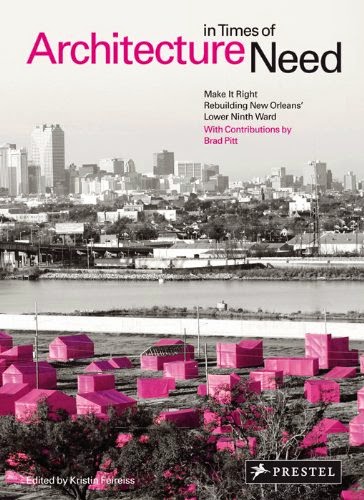Book Review: Architecture in Times of Need
Architecture in Times of Need: Make It Right - Rebuilding New Orleans' Lower Ninth Ward edited by Kristin Fieriess with contributions by Brad Pitt, published by Prestel, 2009. Paperback, 488 pages. (Amazon)

As a souvenir of my recent visit to New Orleans for the AIA National Convention I picked up a copy of this book on Make It Right's (MIR) rebuilding in the Lower Ninth Ward. MIR is known far and wide because it was started and promoted by Brad Pitt, A-list actor, one half of Brangelina, and architecture aficionado. But Pitt's efforts with MIR is hardly a celebrity throwing money and pink houses at a place in order to realize some cutting edge architecture, and those inclined to think so might want to take a look at the thorough documentation of the project as found in this book. Sure, the Brad Pitt adoration found throughout the book can be a put-off at times, but for the most part the text, images, and the project itself focuses on the families of the Lower Ninth Ward.
The area is now internationally known from the flooding that killed many, displaced just about everybody, and destroyed houses, many owned; in fact the neighborhood had one of the highest ownership rates in New Orleans. Photos of the devastation start the book, followed by responses to the question, both general to the city and localized to the ward, "why rebuild?" A good deal of background on the city and the area is also given early in the book, helping to establish a context for the rest of the book. And the rest basically traces the project with a narrative-like quality that is aided by multiple voices and the sharing of important things often glossed over in architecture books, such as community meetings and financing.
Nevertheless the bulk of the book is comprised of the house designs by architects local (e.g. Eskew+Dumez+Ripple, Trahan Architects), national (e.g. Morphosis, KieranTimberlake), and international (e.g. David Adjaye, Shigeru Ban), all overseen by executive architect John C. Williams. The houses can be seen as variations on traditional themes, contemporary to the core but focused on sustainability and enabling residents to cope with future floods if and when they happen. The documentation of the designs in this book is very good, going beyond the money-shot renderings to include plans, sections (I found the sections most telling of how successful the architects addressed the concerns), and diagrams of sustainable features. A few photos of completed houses come at the back of the book, and while they show that the relatively low budgets (targeting $150/sf) downgrade some of the features and/or gloss of the designs they also show progress. As of writing this review, close to 80 houses are completed or under construction. On my next trip to New Orleans I'll need to venture beyond downtown and the French Quarter to see how contemporary architecture can help (re)create a neighborhood.

As a souvenir of my recent visit to New Orleans for the AIA National Convention I picked up a copy of this book on Make It Right's (MIR) rebuilding in the Lower Ninth Ward. MIR is known far and wide because it was started and promoted by Brad Pitt, A-list actor, one half of Brangelina, and architecture aficionado. But Pitt's efforts with MIR is hardly a celebrity throwing money and pink houses at a place in order to realize some cutting edge architecture, and those inclined to think so might want to take a look at the thorough documentation of the project as found in this book. Sure, the Brad Pitt adoration found throughout the book can be a put-off at times, but for the most part the text, images, and the project itself focuses on the families of the Lower Ninth Ward.
The area is now internationally known from the flooding that killed many, displaced just about everybody, and destroyed houses, many owned; in fact the neighborhood had one of the highest ownership rates in New Orleans. Photos of the devastation start the book, followed by responses to the question, both general to the city and localized to the ward, "why rebuild?" A good deal of background on the city and the area is also given early in the book, helping to establish a context for the rest of the book. And the rest basically traces the project with a narrative-like quality that is aided by multiple voices and the sharing of important things often glossed over in architecture books, such as community meetings and financing.
Nevertheless the bulk of the book is comprised of the house designs by architects local (e.g. Eskew+Dumez+Ripple, Trahan Architects), national (e.g. Morphosis, KieranTimberlake), and international (e.g. David Adjaye, Shigeru Ban), all overseen by executive architect John C. Williams. The houses can be seen as variations on traditional themes, contemporary to the core but focused on sustainability and enabling residents to cope with future floods if and when they happen. The documentation of the designs in this book is very good, going beyond the money-shot renderings to include plans, sections (I found the sections most telling of how successful the architects addressed the concerns), and diagrams of sustainable features. A few photos of completed houses come at the back of the book, and while they show that the relatively low budgets (targeting $150/sf) downgrade some of the features and/or gloss of the designs they also show progress. As of writing this review, close to 80 houses are completed or under construction. On my next trip to New Orleans I'll need to venture beyond downtown and the French Quarter to see how contemporary architecture can help (re)create a neighborhood.
Comments
Post a Comment
Comments are moderated for spam.